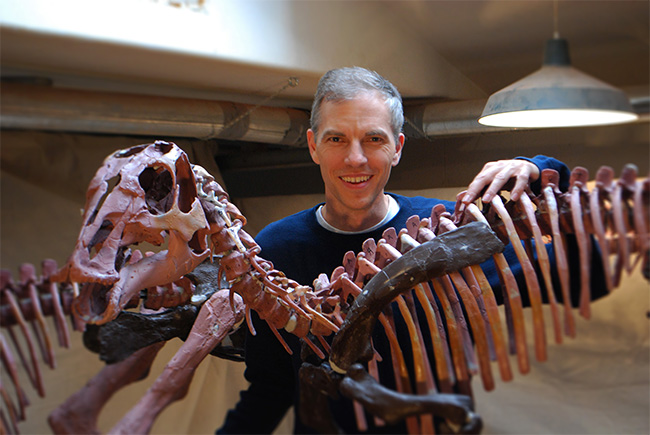
This reconstruction of the Ugrunaaluk kuukpikensis is the result of 3D printing and scanning . Courtesy of 3DS.
Latest News
September 25, 2015
To go by Dr. Jones’ example, the most useful piece of equipment an archaeologist can own is a bullwhip. In reality, the most useful tools currently in use by archaeologists, paleontologists and geologists might be 3D scanning and 3D printing. The flexibility of digital reconstruction has been shown time and time again.
For the last five years, Florida State University and the University of Alaska Fairbanks have collaborated in digging up dinosaur remains from a rich new source called the Liscomb Bonebed found almost 300 miles northwest of Fairbanks, AK. The jewel of the dig thus far is a brand new species of dinosaur that has been named Ugrunaaluk (pronounced oo-GREW-na-luck) kuukpikensis (pronounced KOOK-pik-en-sis) which means “ancient grazer.”
 This reconstruction of the Ugrunaaluk kuukpikensis is the result of 3D printing and scanning . Courtesy of 3DS.
This reconstruction of the Ugrunaaluk kuukpikensis is the result of 3D printing and scanning . Courtesy of 3DS.Researchers have dubbed the area a lost world, claiming that many of species of dinosaurs found in the Liscomb Bonebed are completely different from those found elsewhere.
”So far, all dinosaurs from the Prince Creek Formation that we can identify as species are distinct from those found anywhere else,” said Pat Druckenmiller, museum curator of Earth Science and associate professor of Geology at the University of Alaska Fairbanks. “The recognition of Ugrunaaluk kuukpikensis provides further evidence that the dinosaurs living in polar latitudes in what is now Alaska were not the same species found from the same time periods in lower latitudes.”
Given that time isn’t necessarily kind even to things buried in the ground, the scientists are forced to reconstruct skeletons that are often missing pieces or simply don’t fit together properly. The solution to these problems is 3D printing and scanning.
Using plaster casts of the bones, rather than risking damage to the originals, Michael Holland of Michael Holland Productions, and Ian Sayers from Peak Solutions, a 3D scanning and printing service bureau, began the digital reconstruction efforts.
“We could have estimated or been creative about what the skull looked like, but we would have had serious asymmetry and distortion if we did,” said Holland. “The scientific approach was to take complete fossils in a 3D scan and be able to mirror and accurately replicate them. We could only do that with 3D scanning and 3D printing.”
Sayers and Holland scanned plaster casts of the bestthe best sample fossils using 3D Systems’ Geomagic Capture 3D scanner and Geomagic Wrap for processing the scan data.
“The scan data was taken in a minute or two, processed in Geomagic Wrap and mirrored in another few minutes, and then it was ready to 3D print in the 3D Systems ProJet 660,” said Ian Sayers, Peak Solutions.
After the dinosaur bone replicas were printed out, the skeletal reconstruction process began. Using a mix of 3D printed bones and plaster cast pieces, Holland was able to completely reconstruct the Ugrunaaluk kuukpikensis, giving researchers their first good look at what they had uncovered.
“This is a very cool and real example of how 3D digital scanning and printing is revolutionizing what we do in our profession – not just for display but for research overall,” said Druckenmiller. ”As a result, we are able to reconstruct a new species of dinosaur for the exhibit – faster than we ever could before.”
Below you’ll find a video about the new dinosaur and the dig.
Sources: 3D Systems, University of Alaska Fairbanks
Subscribe to our FREE magazine, FREE email newsletters or both!
Latest News
About the Author
John NewmanJohn Newman is a Digital Engineering contributor who focuses on 3D printing. Contact him via [email protected] and read his posts on Rapid Ready Technology.
Follow DE





